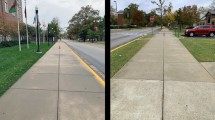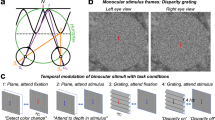Abstract
A biological system is often more efficient when it takes advantage of the regularities in its environment1,2. Like other terrestrial creatures, our spatial sense relies on the regularities associated with the ground surface2,3,4,5,6. A simple, but important, ecological fact is that the field of view of the ground surface extends upwards from near (feet) to infinity (horizon)2. It forms the basis of a trigonometric relationship wherein the further an object on the ground is, the higher in the field of view it looks, with an object at infinity being seen at the horizon. Here, we provide support for the hypothesis that the visual system uses the angular declination below the horizon for distance judgement. Using a visually directed action task7,8,9,10, we found that when the angular declination was increased by binocularly viewing through base-up prisms, the observer underestimated distance. After adapting to the same prisms, however, the observer overestimated distance on prism removal. Most significantly, we show that the distance overestimation as an after-effect of prism adaptation was due to a lowered perceived eye level, which reduced the object's angular declination below the horizon.
This is a preview of subscription content, access via your institution
Access options
Subscribe to this journal
Receive 51 print issues and online access
$199.00 per year
only $3.90 per issue
Buy this article
- Purchase on Springer Link
- Instant access to full article PDF
Prices may be subject to local taxes which are calculated during checkout




Similar content being viewed by others
References
Attneave, F. Informational aspects of visual perception. Psychol. Rev. 61, 183–193 (1954).
Gibson, J. J. The Perception of the Visual World (Houghton Mifflin, Boston, 1950).
Sedgwick, H. A. in Human and Machine Vision (eds Rosenthal, A. & Beck, J.) 425–458 (Academic, New York, 1983).
Sedgwick, H. A. in Handbook of Perception and Human Performance (eds Boff, K. R., Kaufman, L. & Thomas, J. P.) 21.1–21.57 (Wiley, New York, 1986).
Sinai, M. J., Ooi, T. L. & He, Z. J. Terrain influences the accurate judgement of distance. Nature 395, 497–500 (1998).
Meng, J. C. & Sedgwick, H. A. Distance perception mediated through nested contact relations among surface. Percept. Psychophys. 63, 1–15 (2001).
Thomson, J. A. Is continuous visual monitoring necessary in visually guided locomotion? J. Exp. Psychol. Hum. Percept. Perform. 9, 427–443 (1983).
Rieser, J. J., Ashmead, D., Talor, C. & Youngquist, G. Visual perception and the guidance of locomotion without vision to previously seen targets. Perception 19, 675–689 (1990).
Loomis, J., DaSilva, J., Fujita, N. & Fukusima, S. Visual space perception and visually directed action. J. Exp. Psychol. 18, 906–921 (1992).
Loomis, J., DaSilva, J., Philbeck, J. W. & Fukusima, S. Visual perception of location and distance. Curr. Dir. Psychol. Sci. 5, 72–77 (1996).
Warren, W. H. & Whang, S. Visual guidance of walking through apertures: Body-scaled information for affordances. J. Exp. Psychol. Hum. Percept. Perform. 13, 371–383 (1987).
Held, R. & Freedman, S. Plasticity in human sensorimotor control. Science 142, 455–462 (1963).
Hay, J. C. & Pick, H. L. Jr Visual and proprioceptive adaptation to optical displacement of the visual stimulus. J. Exp. Psychol. 71, 150–158 (1966).
Sugita, Y. Global plasticity in adult visual cortex following reversal of visual input. Nature 380, 523–526 (1996).
Rieser, J. J., Pick, H. L. Jr, Ashmead, D. H., & Garing, A. E. Calibration of human locomotion and models of perceptual-motor organization. J. Exp. Psychol. Hum. Percept. Perform. 21, 480–497 (1995).
Matin, L. et al. Oculoparalytic illusion: Visual-field dependent spatial mislocalization by humans partially paralyzed with curare. Science 216, 198–201 (1982).
Stoper, A. & Cohen, M. Judgments of eye level in light and in darkness. Percept. Psychophys. 40, 311–316 (1986).
Gogel, W. C. & Tietz, J. D. Absolute motion parallax and the specific distance tendency. Percept. Psychophys. 13, 284–292 (1973).
Epstein, W. Perceived depth as a function of relative height under three background conditions. J. Exp. Psychol. 72, 335–338 (1966).
Wallach, H. & O'Leary, A. Slope of regard as a distance cue. Percept. Psychophys. 31, 145–148 (1982).
Philbeck, J. W. & Loomis, J. M. Comparison of two indicators of perceived egocentric distance under full-cue and reduced-cue conditions. J. Exp. Psychol. Hum. Percept. Perform. 23, 72–85 (1997).
Acknowledgements
We thank K. A. May and P. J. Gunther for their assistance in collecting the data in the first experiment. This research was supported in part by grants from the Knights Templar Eye Foundation and the Southern College of Optometry (to T.L.O.) and a Competitive Enhancement Grant from the University of Louisville (to Z.J.H.).
Author information
Authors and Affiliations
Corresponding author
Rights and permissions
About this article
Cite this article
Ooi, T., Wu, B. & He, Z. Distance determined by the angular declination below the horizon. Nature 414, 197–200 (2001). https://doi.org/10.1038/35102562
Received:
Accepted:
Issue Date:
DOI: https://doi.org/10.1038/35102562
This article is cited by
-
Measuring up the World in Size and Distance Perception
Erkenntnis (2024)
-
Simulated eye height impacts size perception differently depending on real-world posture
Scientific Reports (2023)
-
CAVE and HMD: distance perception comparative study
Virtual Reality (2023)
-
Perception of the non-dominant hand as larger after non-judgmental focus on its details
Scientific Reports (2022)
Comments
By submitting a comment you agree to abide by our Terms and Community Guidelines. If you find something abusive or that does not comply with our terms or guidelines please flag it as inappropriate.



